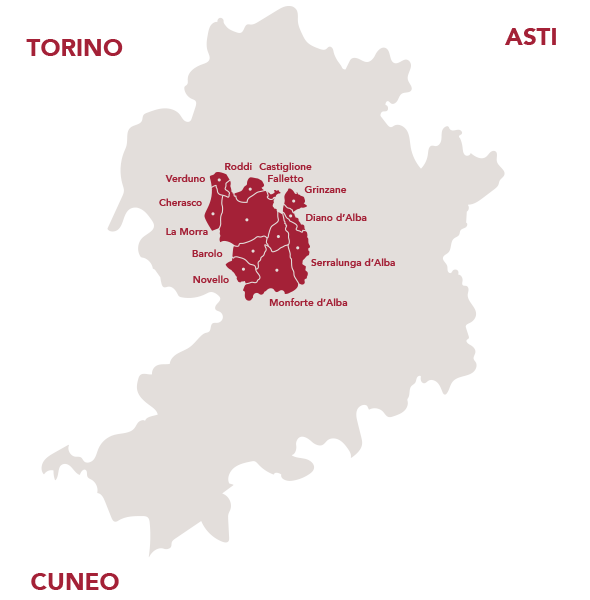Barolo DOCG Piemont
Barolo DOCG
Barolo je nejslavnìjí èervené víno Piemontu spadající do prestiní kategorie DOCG (Denominazione di Origine Controllata e Garantita). Víno je vdy tvoøené ze 100 % modrou odrùdou Nebbiolo.
Pro vína Barolo je typická vyí kyselina a vysoké tøísloviny. Vlastnosti tìchto vín je pøedurèují k dlouhému archivaènímu potenciálu i nìkolik desítek let.
Oblast pùvodu hroznù Barolo
Území obcí... Barolo, Castiglione Falletto, Serralunga d'Alba a èásteènì obce Monforte d'Alba, Novello, La Morra, Verduno, Grinzane Cavour, Diano d'Alba,
Cherasco a Roddi spadající do provincie Cuneo.

Barolo DOCG
It has a full and intense garnet color. At the same time fruity and spicy perfume which is reminiscent of small red fruits, cherries in alcohol and jam, but also offers suggestions of rose and dried violet, cinnamon and pepper, nutmeg, vanilla and sometimes licorice, cocoa, tobacco and leather. The taste is harmonious with elegant and complex tannins. Elegant and powerful wine at the same time.
This is the Grand Italian Wine by definition, also produced entirely with Nebbiolo grapes. Barolo wine comes from the village in the Langa bearing the same name a few kilometres south of Alba. It is now made in eleven communes or village territories, all situated on the scenic Langa hills shaped by centuries of vine cultivation and dominated by medieval castles including Barolos own.
Thanks to the farming genius of Count Camillo Benso of Cavour (who was also Italys first Prime Minister) and to the intuition of Giulia Colbert Falletti, the last Marquess of Barolo, Barolo wine began to be produced around halfway through the 19th century. This wine, particularly rich and harmonious, became the Savoy Familys best ambassador, representing Piedmont in all the royal courts of Europe.
Together with Barbaresco, Barolo saw the rise of many associations in its favour during the course of 20th century, starting with Pro-Barolo and culminating in the foundation of the Consortium and the attribution of Doc and then Docg status and, finally, in 2005, the Control Plan for Certification required by the European Union.
These captivating qualities led the nobility of the 19th century to give it the title King of wines and wine of kings. Barolo must be allow to age for at least three years, one and a half of which has to be in oak barrels. If the ageing is prolonged for five years, the wine gains the title of Riserva.
